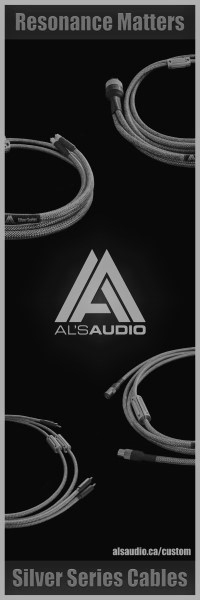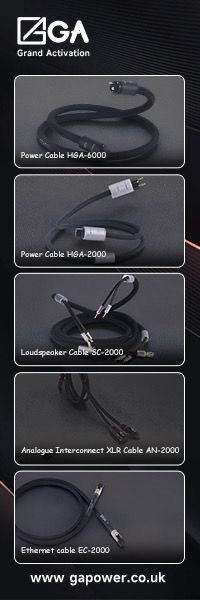Audio Acoustics – Sapphire Ti-C SE Loudspeakers
| Audio Acoustics – Sapphire Ti-C SE Loudspeakers |
| Seriously Musical Speakers from the U.K. |
|
|
|
April 2008 |

EARLY INTRODUCTION
The CES can be a particularly good event, not just for seeing and hearing new products but also for the opportunity to network and reconnect with friends, colleagues and other industry folks. It was during the 2006 CES that I was introduced to Daniel Barnum of Half-Note Audio. At the time, he was the importer for a line of breathtakingly built though very expensive loudspeakers from a UK-based company called Audio Acoustics. After much discussion, Daniel arranged for me to receive a pair of the company’s $128K Sapphire Ti-C SE loudspeakers for review.
Quite frankly, given the price of this speaker, I looked forward to assessing its design and performance. Both speakers arrived safely housed in shipping containers. After hauling them around to the back of my home, where we could easily place the speakers into my listening area, I then assisted (OK, I mainly watched) as Barnum carefully removed each speaker from their containers. I appreciated having someone who could to do the heavy lifting as well as handle these speakers so carefully and meticulously.
Each speaker comes permanently fitted with spiked cones. While this is a nice feature, it definitely added to the challenge of moving them around and placing them in my preferred listening position. Fortunately, Barnum was quite familiar with how to best maneuver them and got them positioned so we could check them out and make sure they were operating properly.
Upon my initial visual inspection, I was very impressed and could tell these Audio Acoustic Sapphire loudspeakers were solidly built and finished. I was anxious to start doing some listening. But first, Daniel rather carefully and methodically took a series of measurements from both the side and rear walls to determine where he felt might be optimal placement for these speakers. In the end, the speakers were placed at nearly the same spot that my reference ESP Concert Grand SI loudspeakers were.
Along with the speakers, Daniel also brought Audio Acoustics’ top-of-the-line cables: the WOW Resonance interconnects and speaker cables, as well as several AC cords. Additionally, there were special Audio Acoustics discs called Nano Pucks used for isolation and energy transfer for the speakers. In order to assess the overall effectiveness of these products, we systematically placed them in my system one at a time.
DESIGN APPROACH – TECHNICAL AND VISUAL
Speaking with the designer Shabir Bhatti, I quickly sensed his deep and serious passion for immaculate speaker design as well as how best to execute his theories for reaching the highest levels of sonic purity. But just as impressive was the attention to detail in the speakers’ flawless aesthetics. The pair I received came in the superb finish called Titanium Metallic. Additionally, their overall fit and feel, and very good looks, including the angular lines of the speaker, along with its slender profile, help give the speaker a sleek elegant look. Being able to easily integrate these looks into just about any room configuration or decor is an absolute plus and something the designer obviously took into consideration.
According to Bhatti, the design – in respect to his loudspeakers – is the result of intense research and development to produce a loudspeaker with no compromise. His design approach specifically covers important areas such as: enclosure, port, diffraction, drive units, resonance control, cables, crossover network and floor coupling. Specifically, his design approach addresses removal of multiple resonances that are typically overlooked in various commercial designs with the ultimate goal being to offer a speaker with dramatically superior dynamic range along with as high a level of naturalness possible.
In particular, the Audio Acoustic Sapphire’s enclosure is a six-layer laminated cabinet incorporating three types of membrane, each with its own specific characteristics, along with stainless steel panels. The specific purpose of this design is to control vibrations – not simply add mass and stiffness. This design also effectively addresses the elimination of cabinet coloration and enclosure distortion. Additionally, these speakers incorporate a port on the lower front of the speaker. Fortunately, I was unable to detect any ill effects so often noted with speakers having a port design. This port was uniquely designed for optimum airflow control and for eliminating various aspects of internal air compliance factors.
Careful attention has also been given to produce a structure addressing cabinet edge diffraction along with internal shaping to eliminate internal standing waves, specifically in conjunction with the third membrane. Also, a time-aligned driver layout enhances the point source approach of the speaker. Audio Acoustics seeks out the very finest and most technically advanced drive units with the goal, according to the designer, to employ drivers that have diaphragm motion that is strictly pistonic and free from resonance across a wider bandwidth than the frequency range the drive unit is required to operate.
Also, the unique sapphire diaphragms used have only a fraction of the mass of conventional drivers, yet are purported to boast superb levels of stiffness compliments of complex magnet structures. Also according to the designer, Audio Acoustics uses drivers with titanium voice coils resulting in distortion elimination, high definition and resolution with superb transient power and extended, organic bass. As stated by the designer, one of his primary goals is to produce a “quiet” speaker where only the sounds from the driver diaphragms are heard and not accompanied by extraneous sounds caused by uncontrolled resonances or vibrations.
Perusing the Audio Acoustic loudspeaker website, I found loads of information on Bhatti himself; his design theories and concepts but perhaps more importantly his reasons as to why he decided to build the Audio Acoustics Sapphire loudspeaker in the first place [here]. Shucks, one may never justify how a loudspeaker can claim a $128k retail price ticket but after reading and digesting all the data behind such a terrific product, it did help me in understanding Bhatti’s design and his company Audio Acoustic, a lot better.
In the area of cables, the Wow Resonance cables are an extension of Bhatti’s research and attempt to create system synergy for his loudspeakers. The network crossovers contain, according to Bhatti, the finest component parts available with near zero-tolerance silver capacitors and air-core inductors. Additionally, says Bhatti “they incorporate top quality silver with extensive use of resonance-controlling membranes. They are then torqued into place to form a harmonious compound sealed structure.”
Lastly, the spikes employed are a 3-point, floor-coupling system designed to address superior energy isolation. The spikes are machined from steel, receive repeated hardening and are nickel-plated (and polished). According to Bhatti, this process produces a hardness close to titanium resulting in a durable point capable of supporting the heavy speakers. These are then coupled to the Nano Pucks which are designed for energy transfer and isolation control.
![]()
Don’t forget to bookmark us! (CTRL-SHFT-D)
Stereo Times Masthead
Publisher/Founder
Clement Perry
Editor
Dave Thomas
Senior Editors
Frank Alles, Mike Girardi, Russell Lichter, Terry London, Moreno Mitchell, Paul Szabady, Bill Wells, Mike Wright, and Stephen Yan,
Current Contributors
David Abramson, Tim Barrall, Dave Allison, Ron Cook, Lewis Dardick, John Hoffman, Dan Secula, Don Shaulis, Greg Simmons, Eric Teh, Greg Voth, Richard Willie, Ed Van Winkle, Rob Dockery, Richard Doron, and Daveed Turek
Site Management Clement Perry
Ad Designer: Martin Perry






Be the first to comment on: Audio Acoustics – Sapphire Ti-C SE Loudspeakers